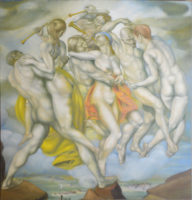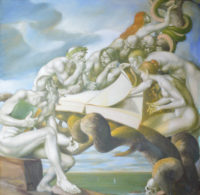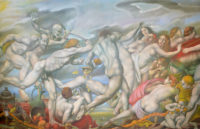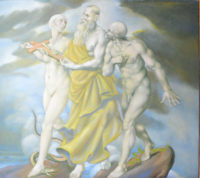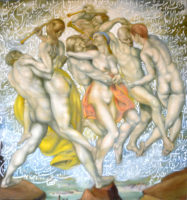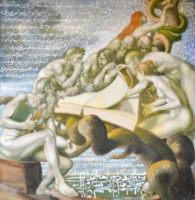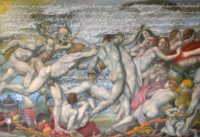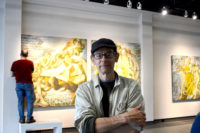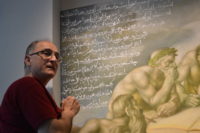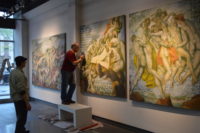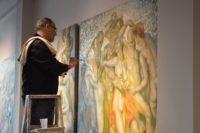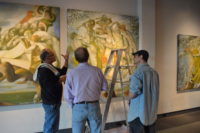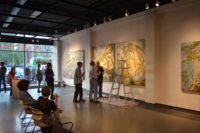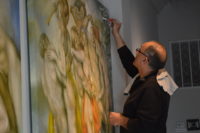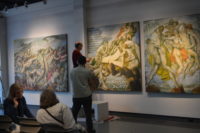Ernesto Montenegro: Right to Left, What’s Left to Write?
R. Michelson Galleries and A.P.E. Gallery join to present a performance artwork enacting a dialogue between two cultures.
at A.P.E. Gallery 126 Main St. Northampton (next door the the gallery)
Friday May 11, 5-8 pm in conjunction with Northampton’s Arts Night Out
Saturday May 12, 12-5 pm and Sunday May 13, 12-5 pm
and see a display of Mr. Montenegro’s flatmensquared sculptures on the main floor of R. Michelson Galleries.
Over forty years ago, sculptor, then painter, Ernesto Montenegro was commissioned to do a series of Renaissance-style paintings for a residence in Boston’s South End. His career has since turned from painting to sculpture and his works can be seen in public spaces across the country including the Gateway to Manchester in NH, the Cyclist in Greenfield, MA, and the 53-foot Ourhandsthenandnow in Claremont, NH, in celebration of the town’s 250th anniversary.
Dr. Foad fled Iran in the late 1970’s as a 16-year-old boy fearing danger because of his Baha’i faith which was prohibited and was widely persecuted in the new Islamic Republic. He came to the United States and educated himself at Boston University and Harvard University.
Mr. Montenegro had recently re-acquired this series of paintings and joined with Dr. Foad for an event and conversation about cultural fusion. Dr. Foad engaged the audience in a dialogue and with their help wrote a narrative over these paintings in the calligraphy of Ancient Persia, his native language of Farsi.
In our time of political polarization, cultural identity has brought with it both opportunity and strife. This event was intended to start a conversation about the nature of those identities and how they can co-exist.
Separate events happened on Friday, Saturday, and Sunday as each of the four panels were transformed through cooperation with the audience.
72×64 in
72×70 in
72×106 in
60×68 in
72×64 in
72×70 in
72×106 in
60×68 in
Images from the event:
Statements from the Artists:
The current political atmosphere is bent on reversing more than fifty years of hard-earned progress toward a civil equity. The present administration has unleashed a reactionary behavior that insults and abuses what it really means to be American. It is our belief that cultural integration is beneficial to the health of every community, and we would like to use our platform as artists to demonstrate this belief. Our intention is to re-purpose and transform one of my early works of art into a contemporary illustration of this conviction.
Recently, I re-obtained a mural I was commissioned to paint more than forty years ago in a home in Boston’s South End. Now that the mural has been removed from its original space, I would like to enhance its original motive and deepen its title ‘Paradise Lost’ into a present tense purpose of political dimension.
My collaborator Dr. Foad was born in Iran and immigrated to the U.S. at about the same time I was commissioned to paint this mural. He was at the time learning English and navigating his newly adopted and different culture while at the same time able to attain a degree in psychology from Boston University and a Masters from Harvard. His native language of Farsi and capacity to write in the beautiful script of ancient Persian calligraphy is what allows us to bring about this event. The painting and writing lend themselves to a directional metaphor: Farsi is written right to left as the mural moves from left to right and we all meet in the middle.
By appropriating my original work and adding a narrative in Farsi, we intend to demonstrate a positive mixture of Middle Eastern sensibility with Western style figuration. This fusion aims to create a visual dialogue and a dynamic collaboration across decades and cultures.
-Ernesto Montenegro
Regarding the Calligraphy Script
We write to preserve time, to communicate about what was, or what is. It’s the ethereal nature of time that humans try so hard to capture with script. I also see script not just as lines but as the 2-D representation of a ribbon moving and bending in space. I am not confined to words with meanings as I think the lines, bends, orientation, and their relationship to each other are, visually, more important than whether they form an ‘actual’ word or not. So I may combine forms that mean nothing but represent the essence of an idea, thought, emotion, or experience.
Both words, music and movement enter our consciousness one small segment at a time. Each sound or note followed by another either creates a musical tone and it leaves, but our memory (time capturing device) allows us to hear a long series of them as a whole. The same with movement. We see a series of positional spaces through each eye, coordinate them into 3-D and connect them with the next positional set point and through a series of complex processes, see movement. Now, consider also that when a word is uttered or written, it is birthed. But in the process of being connected to other words it expands not only its own meaning but also that of the words to which it is attached. In the same way, our work on this piece combines all of this. Ernest will never produce these paintings again. I will never have a chance to write on them again. The experience cannot be repeated and yet it will be experienced and remembered as a time capsule.
-Dr. Foad

